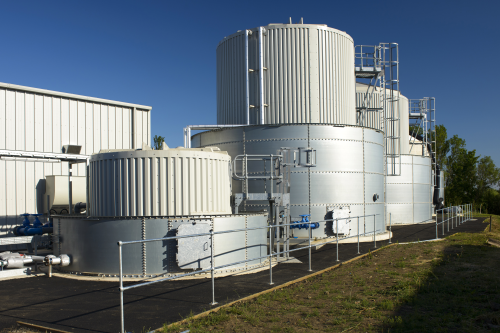
The on-site bio-energy plant was designed and built by ClearfleauTM for food sector client, global food and beverage supplier Nestlé's Fawdon confectionery factory, near Newcastle. The financial and environmental benefits from Clearfleau's plant are contributing to Nestlé's efforts to develop environmentally-sustainable manufacturing at Fawdon, as a beacon site for the overall organisation.
AD plant balance tanks.
One year after commissioning, the plant is converting 200,000 litres per day of feedstock into renewable energy. This feedstock includes wash waters from the site and 1,200 tonnes of residual bi-products and ingredients per annum.
Heat and power
The biogas produced is fuelling a combined heat and power (CHP) engine, which produces 200 kW of electricity, used in the confectionery production process. This is about 8% of the factory’s power requirements, cutting the annual electricity bill by about £100,000 per annum. In addition, the site has registered for the Feed-in Tariff, and will receive annual payments of about £250,000 per annum.
Previously, production residues from Fawdon, the former Rowntree factory, home to gums, pastilles and Rolo’s, were discharged to sewer or fed to pigs in the locality. Following the installation of the AD plant, all bio-degradable production residues are now converted into renewable energy on the factory site. Clearfleau used their mobile trial unit to showcase the digestion technology to the management and workforce at the Fawdon site before construction and to help optimise the process design.
Nestlé's Head of Sustainability, Inder Poonaji, says:“We chose Clearfleau because we wanted a partner with experience who would design a plant to meet our specific needs. On-site treatment of production residues will help us reduce the wider environmental impact of our business and meet our sustainability goals. We continue to reduce our carbon footprint and generate value from food production residues."
Interior of solids dissolution building.
Compact design
Key reasons why Clearfleau’s design was chosen include its high-rate liquid based digestion system, which uses a robust solids-processing system, together with its compact design to fit on the edge of the factory car park.
In addition to saving on fossil fuel purchase plus the other savings and revenue benefits, the project has reduced the carbon footprint and environmental impact of the site. The carbon footprint for anaerobic digestion is at least seven times smaller than for conventional aerobic treatment plants.
The payback period on Nestlé's investment in Clearfleau 's AD plant is predicted to be four-five years. The company 's Chief Executive, Craig Chapman, says: "Clearfleau was delighted to be selected by Nestlé to deliver this important plant and we very much appreciate their collaborative approach to the delivery of this project. For Nestlé, what was previously a processing overhead is now a valuable financial and environmental asset.
“The advantages of anaerobic digestion are becoming more apparent and we are currently building AD plants on dairy, distillery, food and biofuel manufacturing sites. As a consequence of this industry support, we have built a strong team delivering on-site anaerobic digestion facilities."
Clearfleau awards
• Nominated for 2014 Sustainability Business Leaders Awards – for the Waste Treatment Award.
• Winner of the UK AD & Biogas Industry Awards 2014 for Best Small-Scale AD Project (www.clearfleau.com/nws/clearfleau-wins-uk-ad--biogas-award-2014)
• Winner of the Scottish Green Energy Awards 2013 for Best Project Award - Clearfleau and Diageo Scotland (www.clearfleau.com/news/bio_energy-project-wins-2013-scottish-green-energy-award)
• Award for Excellence in recycling and waste management 2011 (www.clearfleau.com/news/winner-of-innovation-in-design-of-a-waste-management-facility-)




